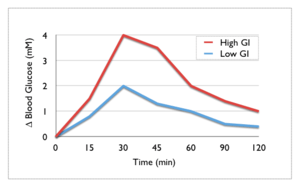Postprandial glucose test
| Postprandial glucose test | |
|---|---|
| Medical diagnostics | |
 Changes in blood glucose over time following a high and low glycemic index (GI) carbohydrate. | |
| Purpose | determines the amount of a type of sugar after a meal |
A postprandial glucose test is a blood glucose test that determines the amount of a type of sugar, called glucose, in the blood after a meal. Glucose is mainly made from carbohydrate foods. It is the main source of energy used by the body.
Normally, blood glucose levels increase slightly after eating. This increase causes the pancreas to release insulin, which assists the body in removing glucose from the blood and storing it for energy. People with diabetes may not produce or respond properly to insulin, which causes their blood glucose to remain elevated. Blood glucose levels that remain high over time can damage the eyes, kidneys, nerves, and blood vessels.
A 2-hour postprandial blood glucose test ("2 hour p.c. blood glucose test", etc.) measures blood glucose exactly 2 hours after eating a meal,[1] timed from the start of the meal.[2] By this point blood sugar has usually gone back down in healthy people, but it may still be elevated in people with diabetes. Thus, it serves as a test of whether a person may have diabetes, or of whether a person who has diabetes is successfully controlling their blood sugar.
Purpose
Blood glucose tests are done to:
- Check for and monitor the treatment of diabetes.[1]
- Check for diabetes that occurs during pregnancy gestational diabetes.[1]
- Determine if an abnormally low blood sugar level hypoglycemia is present.[1]
Procedure
For a 2-hour postprandial test, a meal is eaten exactly 2 hours before the blood sample is taken. A home blood sugar test is the most common way to check 2-hour postprandial blood sugar levels.
The health professional taking a blood sample will:[1]
- Wrap a tourniquet around the upper arm to stop the flow of blood. This makes the veins below the band larger so it is easier to put a needle into the vein.
- Clean the needle site with 70% isopropyl alcohol.
- Put the needle into the vein at a 10–30 degree.
- Place the vacutainer tube into the vacutainer holder of the needle to fill it with blood.
- Remove the tourniquet from the arm when the tube is almost filled.
- Apply a gauze pad or cotton ball over the needle site as the needle is removed.
- Apply pressure to the site and then a bandage.
Results are often ready in 1 to 2 hours. Glucose levels in a blood sample taken from the vein (called a blood plasma value) may differ a little from glucose levels checked with a finger stick.
Reference ranges
The American Diabetes Association recommends a postprandial glucose level under 140mg/dl (7.8mmol/L) and a preprandial plasma glucose between 90–130 mg/dl (5-7.2mmol/L). [3][4]
High values may indicate diabetes. However, doctors will not use just one test result to diagnose the condition.